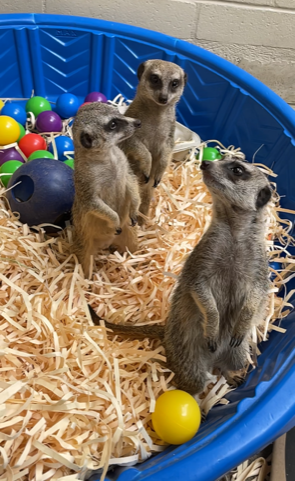Community website by MBC/Ernest Abrams. Call 808-739-9797 for advertising/sponsorship.
Waikiki Get Down - Honolulu, Hawaii
News Item- Powered by MBC NewsMaker
New Meerkats Placed On Exhibit At Honolulu Zoo
- Tweet

Meerkats Raphael, Leo and Mikey.
HONOLULU – The Honolulu Zoo is happy to welcome three new male meerkats from the Toledo Zoo. Brothers Raphael, Leo and Mikey were born on March 4, 2017 and arrived at the Honolulu Zoo on November 2. They have just completed their 120-day quarantine period and have been placed on exhibit for the public to visit.
For pictures and a video of the new meerkats, please click the following link:
https://drive.google.com/drive/folders/1Vk3CHZAcYezebAi7_RVGlDrkXJn7MjpS?usp=sharing
Meerkats, also known as suricates, are a type of small burrowing mongoose found in Southwestern Africa and are recognizable by their upright “sentinel” posture as they look out for predators. They live in rock crevices and large burrow systems of underground tunnels. They forage in packs of three to 25 individuals and are generally gray or tan in color with a black-tipped tail and dark patches around their eyes to protect them from the glare of the sun. Meerkats primarily feed on insects including beetles, termites, spiders, scorpions, and also on lizards, small snakes, rodents and birds and dig up succulent tubers to obtain water.
The population is not threatened and meerkats are found to breed year-round, giving birth to litters of three to seven pups.
As meerkats are considered injurious wildlife in Hawaiʻi, the Honolulu Zoo is only allowed to house male meerkats to avoid any risk of this species getting established in the wild.
The three meerkats were provided to the Honolulu Zoo as part of a partnership with the Association of Zoos and Aquariums (AZA) and their Species Survival Plan (SSP). The International Union for Conservation of Nature (IUCN) has listed meerkats as “Least Concern” on the IUCN Red List.
“We are very happy to have meerkats back on exhibit in the Honolulu Zoo,” said Honolulu Zoo Director Linda Santos. “These popular animals help us to educate the public and we’re thankful for the continued partnership with the AZA and zoo facilities across the country which support us in our conservation education efforts.”
Meerkat pups learn by observing adult behavior. Adults weigh up to two pounds and measure approximately nine to 14 inches in height, not including their tail. The average lifespan is five to 15 years in the wild and have been known to live for more than 12 years in captivity. Meerkats have been made popular as they have been widely portrayed in movies and television programs.
About the Honolulu Zoo:
The mission of the Honolulu Zoo is to inspire stewardship of our living world by providing meaningful conservation education and experiences to our community. The Zoo emphasizes the Pacific Tropical ecosystems and our values of mālama (caring) and hoʻokipa (hospitality).
The Honolulu Zoo is a 42-acre facility with approximately 800 animals and 80 staff. It is one of only two U.S. zoos with an open air, tropical climate facility year-round. The Honolulu Zoo is also a botanical garden with a growing native plant collection. The flora in the zoo are grown to provide habitat and buffer zones for the animals, as well as shade and food. Grounds keeping staff maintain growth to safely and properly support and enhance exhibit areas. The zoo composts its animal and plant waste and uses it to keep plants healthy. Two of the zoo’s support partners, the Honolulu Zoo Society and Service Systems Associates, contribute tremendously to the zoo’s conservation efforts. Staff maintain, manage, check, assess, repair, and improve exhibits and grounds every day of the year. Staff daily uphold USDA and AZA standards. Squirt the giraffe has recently been voted the mayor of Honolulu Zoo.
Questions? Ready for an appointment?
Featured Product/Service
- RELATED LINKS
Calendar
Check out things to do in Waikiki, Hawaii on the calendar of events.News and Newsletters
Keep up with the latest news and happenings in the Waikiki, Hawaii community.Waikiki, Hawaii Featured Pages
View our directory of feature pages showcasing all the great things Waikiki has to offer.Featured Sponsors Offers
Great offers from our sponsors who support the Waikiki, Hawaii Community More...Waikiki, Hawaii Coupons & Discounts
Save money in Waikiki, Hawaii with these coupons.About Waikiki - Honolulu Hawaii
Learn about Waikiki, Hawaii.About Waikiki Get Down.com
Learn about WaikikiGetDown.com website and its creator.
Please send questions about this website to
Copyright© 2012 - 2021 WaikikiGetDown.com. All rights reserved.
Terms of Use / Legal Disclaimer / Privacy Statement
Site Designed and Managed by MacBusiness Consulting
Terms of Use / Legal Disclaimer / Privacy Statement
Site Designed and Managed by MacBusiness Consulting
